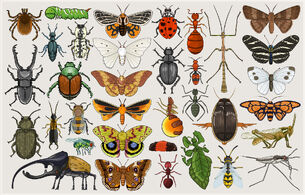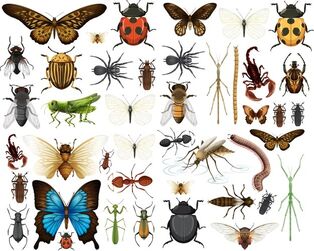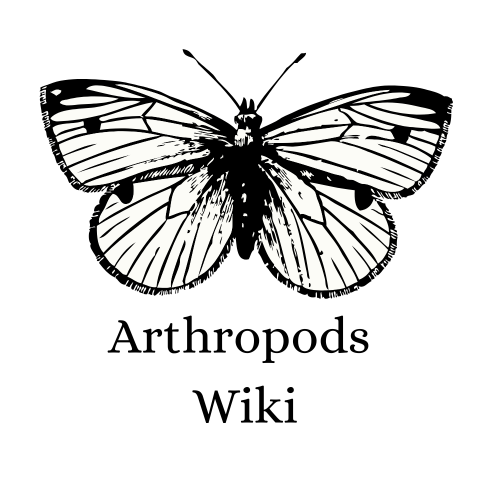For Insecta (Category) Please see Category:Insecta

Insect, (class Insecta or Hexapoda), any member of the largest class of the phylum Arthropoda, which is itself the largest of the animal phyla. Insects have segmented bodies, jointed legs, and external skeletons (exoskeletons). Insects are distinguished from other arthropods by their body, which is divided into three major regions: (1) the head, which bears the mouthparts, eyes, and a pair of antennae, (2) the three-segmented thorax, which usually has three pairs of legs (hence “Hexapoda”) in adults and usually one or two pairs of wings, and (3) the many-segmented abdomen, which contains the digestive, excretory, and reproductive organs.

In a popular sense, “insect” usually refers to familiar pests or disease carriers, such as bedbugs, houseflies, clothes moths, Japanese beetles, aphids, mosquitoes, fleas, horseflies, and hornets, or to conspicuous groups, such as butterflies, moths, and beetles. Many insects, however, are beneficial from a human viewpoint; they pollinate plants, produce useful substances, control pest insects, act as scavengers, and serve as food for other animals (see below Importance). Furthermore, insects are valuable objects of study in elucidating many aspects of biology and ecology. Much of the scientific knowledge of genetics has been gained from fruit fly experiments and of population biology from flour beetle studies. Insects are often used in investigations of hormonal action, nerve and sense organ function, and many other physiological processes. Insects are also used as environmental quality indicators to assess water quality and soil contamination and are the basis of many studies of biodiversity.In numbers of species and individuals and in adaptability and wide distribution, insects are perhaps the most eminently successful group of all animals. They dominate the present-day land fauna with about 1 million described species. This represents about three-fourths of all described animal species. Entomologists estimate the actual number of living insect species could be as high as 5 million to 10 million. The orders that contain the greatest numbers of species are Coleoptera (beetles), Lepidoptera (butterflies and moths), Hymenoptera (ants, bees, wasps), and Diptera (true flies).
Biodiversity[]
In a popular sense, “insect” usually refers to familiar pests or disease carriers, such as bedbugs, houseflies, clothes moths, Japanese beetles, aphids, mosquitoes, fleas, horseflies, and hornets, or to conspicuous groups, such as butterflies, moths, and beetles. Many insects, however, are beneficial from a human viewpoint; they pollinate plants, produce useful substances, control pest insects, act as scavengers, and serve as food for other animals (see below Importance). Furthermore, insects are valuable objects of study in elucidating many aspects of biology and ecology. Much of the scientific knowledge of genetics has been gained from fruit fly experiments and of population biology from flour beetle studies. Insects are often used in investigations of hormonal action, nerve and sense organ function, and many other physiological processes. Insects are also used as environmental quality indicators to assess water quality and soil contamination and are the basis of many studies of biodiversity.
Morphological Charactersitics[]
In numbers of species and individuals and in adaptability and wide distribution, insects are perhaps the most eminently successful group of all animals. They dominate the present-day land fauna with about 1 million described species. This represents about three-fourths of all described animal species. Entomologists estimate the actual number of living insect species could be as high as 5 million to 10 million. The orders that contain the greatest numbers of species are Coleoptera (beetles), Lepidoptera (butterflies and moths), Hymenoptera (ants, bees, wasps), and Diptera (true flies).
Lengths[]
The majority of insects are small, usually less than 6 mm (0.2 inch) long, although the range in size is wide. Some of the feather-winged beetles and parasitic wasps are almost microscopic, while some tropical forms such as the hercules beetles, African goliath beetles, certain Australian stick insects, and the wingspan of the hercules moth can be as large as 27 cm (10.6 inches).
Behavior[]
Communication[]
Some insects advertise their presence to the other sex by flashing lights, and many imitate other insects in colour and form and thus avoid or minimize attack by predators that feed by day and find their prey visually, as do birds, lizards, and other insects.
Predatory Adaptations[]
Behaviour is diverse, from the almost inert parasitic forms, whose larvae lie in the nutrient bloodstreams of their hosts and feed by absorption, to dragonflies that pursue victims in the air, tiger beetles that outrun prey on land, and predaceous water beetles that outswim prey in water.In some cases the adult insects make elaborate preparations for the young, in others the mother alone defends or feeds her young, and in still others the young are supported by complex insect societies. Some colonies of social insects, such as tropical termites and ants, may reach populations of millions of inhabitants.
Diversity[]
Scientists familiar with insects realize the difficulty in attempting to estimate individual numbers of insects beyond areas of a few acres or a few square miles in extent. Figures soon become so large as to be incomprehensible. The large populations and great variety of insects are related to their small size, high rates of reproduction, and abundance of suitable food supplies. Insects abound in the tropics, both in numbers of different kinds and in numbers of individuals.If the insects (including the young and adults of all forms) are counted on a square yard (0.84 square metre) of rich moist surface soil, 500 are found easily and 2,000 are not unusual in soil samples in the north temperate zone. This amounts to roughly 4 million insects on one moist acre (0.41 hectare). In such an area only an occasional butterfly, bumblebee, or large beetle, supergiants among insects, probably would be noticed. Only a few thousand species, those that attack people’s crops, herds, and products and those that carry disease, interfere with human life seriously enough to require control measures.
Economical Importance[]
Insects play many important roles in nature. They aid bacteria, fungi, and other organisms in the decomposition of organic matter and in soil formation. The decay of carrion, for example, brought about mainly by bacteria, is accelerated by the maggots of flesh flies and blowflies. The activities of these larvae, which distribute and consume bacteria, are followed by those of moths and beetles, which break down hair and feathers. Insects and flowers have evolved together. Many plants depend on insects for pollination. Some insects are predators of others.
Human Relationship[]
Certain insects provide sources of commercially important products such as honey, silk, wax, dyes, or pigments, all of which can be of direct benefit to humans. Because they feed on many types of organic matter, insects can cause considerable agricultural damage. Insect pests devour crops of food or timber, either in the field or in storage, and convey infective microorganisms to crops, farm animals, and humans. The technology for combatting such pests constitutes the applied sciences of agricultural and forest entomology, stored product entomology, medical and veterinary entomology, and urban entomology.
Agricultural Significance[]
Many insects are plant feeders, and, when the plants are of agricultural importance, humans are often forced to compete with these insects. Populations of insects are limited by such factors as unfavourable weather, predators and parasites, and viral, bacterial, and fungal diseases, as well as many other factors that operate to make insect populations stable. Agricultural methods that encourage the planting of ever larger areas to single crops, which provides virtually unlimited food resources, has removed some of these regulating factors and allowed the rate of population growth of insects that attack those crops to increase. This increases the probability of great infestations of certain insect pests. Many natural forests, which form similar giant monocultures, always seem to have been subject to periodic outbreaks of destructive insects.
Agricultural Threats[]
Many insects are plant feeders, and, when the plants are of agricultural importance, humans are often forced to compete with these insects. Populations of insects are limited by such factors as unfavourable weather, predators and parasites, and viral, bacterial, and fungal diseases, as well as many other factors that operate to make insect populations stable. Agricultural methods that encourage the planting of ever larger areas to single crops, which provides virtually unlimited food resources, has removed some of these regulating factors and allowed the rate of population growth of insects that attack those crops to increase. This increases the probability of great infestations of certain insect pests. Many natural forests, which form similar giant monocultures, always seem to have been subject to periodic outbreaks of destructive insects.
Illness Vectors[]
Many major human diseases are produced by microorganisms conveyed by insects, which serve as vectors of pathogens. Malaria is caused by the protozoan Plasmodium, which spends part of its developmental cycle in Anopheles mosquitoes. Epidemic relapsing fever, caused by spirochetes, is transmitted by the louse Pediculus. Leishmaniasis, caused by the protozoan Leishmania, is carried by the sand fly Phlebotomus. Sleeping sickness in humans and a group of cattle diseases that are widespread in Africa and known as nagana are caused by protozoan trypanosomes transmitted by the bites of tsetse flies (Glossina). Under nonsanitary conditions the common housefly Musca can play an incidental role in the spread of human intestinal infections (e.g., typhoid, bacillary and amebic dysentery) by contamination of food. The tularemia bacillus can be spread by deerfly bites, the bubonic plague bacillus by fleas, and the epidemic typhus rickettsia by the louse Pediculus.
Metamorphosis[]
Egg Stage[]
Most insects begin their lives as fertilized eggs. The chorion, or eggshell, is commonly pierced by respiratory openings that lead to an air-filled meshwork inside the shell. For some insects (e.g., cockroaches and mantids) a batch of eggs is cemented together to form an egg packet or ootheca. Insects may pass unfavourable seasons in the egg stage. Eggs of the springtail Sminthurus (Collembola) and of some grasshoppers (Orthoptera) pass summer droughts in a dry shrivelled state and resume development when moistened. Most eggs, however, retain their water although they may pass the winter in a state of arrested development, or diapause, usually at some early stage in embryonic development. However, dried eggs of Aedes mosquitoes enter a state of dormancy after development is complete and quickly hatch when placed in water.
Nymphal Stage[]
The hatching of young larvae is achieved in several ways. Some, such as caterpillars, bite their way out of the egg. Many, such as the flea, have hatching spines with which they cut a slit in the shell. Some insect eggs have a preformed “escape cap” that the larva pops from the shell by increasing the pressure inside the egg. Depending on the species, this may be accomplished either by swallowing air and then constricting muscles in the body to exert pressure on the cap or by having an expandable region on the head (many Diptera have a ptilinum) that can be extended by hydraulic (blood) pressure. After hatching, the larva continues to distend itself in this way, although the ptilinum collapses back into the body, until the cuticle hardens.
Pupation Period[]
The second stage of complete metamorphosis, A chrysalis or a cocoon is a special term particularly used for the second stage of a lepidopteran. In the case of a butterfly, this term specifically means the caterpillar's final instar in case of moths, it is a cocoon, that is a warm silky blanket spun with silk produced by the juvenile moth. The butterfly caterpillar will suspend itself underneath (Or besides) the previous host plant's stem. Then the caterpillar will molt for the final time in it's life, this time the molting process is quite odd unlike other instars the caterpillar went through earlier in it's life. As it molts it's entire body including it's large bulbous head. A unique transformation is taking place within the chrysalis. Then the caterpillar undergoes a great ordeal where it releases an enzyme called caspases. which dissolves it's muscles, digestive system and smaller organs leaving behind respiratory system and a series of imaginary disks that will then form newer arts including the scales and the wings what allows them to do so are the genetic memory in each disk which turns into a cell. The imaginary disks were earlier stored within the caterpillar's body in the form of Harmons. About 5-7 days, the digestive system of the lepidopteran is ready, by 16-20 days the limbs, head and the thoracic region are all ready. then the adult within the pupa emerges out of the pupa to mate and reproduce and that's all they have to do in their lives that only last for 4-7 weeks. This process occurs in a breath-takingly short period of time compared to other natural changes such as a blossom turning into a fruit or a plant producing buds. Moths often build protection for their own selves by spinning a nice warm and cozy blanket of silk to provide them with warmth and protection overwinter. The adult within releases a corrosive neurotoxin, corroding a small portion of the cocoon large enough for the adult to emerge.
